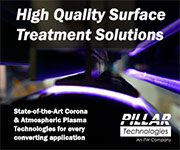New possibilities for beer packaging in PEN and LCP
- Published: September 01, 1996, By Sacharow, Stanley
Beer bottlers are now looking at several innovative new plastics for their containers. For flexible label suppliers, these present new and exciting challenges in bottle decoration. Because of its low pH (about 4.0), microbial degradation is not usually a problem with beer, and the use of pasteurization and aseptic cold filtration excludes wild (i.e., noncultured) yeasts that could thrive. However, during storage beer can undergo irreversible changes leading to the appearance of haze, the development of off-flavors, and increased color. One of the major oxidative reactions is the oxidation of linoleic acid, which gives beer a "cardboard-like" flavor; it has a flavor threshold of as little as 0.1 parts per billion (ppb). Flavor loss is accelerated in the presence of light and certain metal ions.
Because the fermentation process itself consumes oxygen, brewing reduces the level of oxygen in beer down to 40-50 ppb prior to packaging. However, during the packaging process, atmospheric oxygen enters the package, and the level of oxygen contamination reaches 250-500 ppb, which corresponds to 0.1-0.2 mL of oxygen per 335 mL bottle or can. This results in a shelf life for the beer of 80 to 120 days, and, even then, significant flavor deterioration is likely to occur.
A beer drinker can tell the difference between a freshly packaged beer and one that has been packaged for 30 days. Thus, brewers would like to be able to reduce the oxygen level in beer to less than 50 ppb immediately after packaging and hold it at that level for as long as possible.
Currently of great interest among beer bottlers is polyethylene naphthalate (PEN). Work in naphthalate polycondensation polymers has been ongoing since the discovery of polyethylene terephthalate (PET) in the 1940s; however, it is only since 1993 that serious attention has been devoted to this material. These developments include improved oxygen and water barrier, higher temperature resistance, higher strength, and intrinsic ultraviolet light barrier.
At present, PEN provides approximately five times more barrier for carbon dioxide, oxygen, and water vapor transmission than PET. This can be of obvious advantage as a flexible film or in rigid containers for beer. Final Food and Drug Administration approval of PEN homopolymers in April 1996 created even more bottler interest in a PEN beer bottle. Coupled with this interest is the recent launch by both Amoco and Mitsubishi (Japan) of plants that produce the raw materials needed for PEN production.
At the recent Interpak exhibit, Greiner and Sons (Kremsmunster, Austria) exhibited PEN bottles for beer. These were designed as returnable and refillable bottles and were capped with conventional tinplate crowns. Now bets are that by 1997, at least one major US beer bottler will have a PEN bottle onstream.
Even more exotic is the use of liquid crystal polymers (LCPs) as beer bottle resins. Work being done with LCPs at North Carolina State Univ. (Raleigh, NC) is making bottles less permeable than those made by PET. Researchers there successfully developed a detailed molecular structure of airtight polymers. This can make it easier for resin makers to produce a commercially viable material.
Right now there are no commercial bottles being made of this nor of composites made of LCPs and conventional polymers. Researchers are also trying to reduce the thickness of the LCP layers to reduce the cost of the final bottle. Possible future formulations might include the use of an LCP liner with either PET or PEN.
In a paper presented at the American Chemical Society meeting in March, Dr. Benny Freeman of North Carolina State noted, "For beer, keeping oxygen out is the whole ball game. Something like Coca-Cola is not nearly so sensitive to oxygen, so the [carbon dioxide] is the main factor there."
He added, "A successful barrier could lead to use of smaller bottles. The soda industry would really like to have a 12-ounce bottle. But, as you go to smaller size, the amount of surface area of bottle you have per unit pound of soda you package goes up. The rate at which you lose C[O.sub.2] is proportional to the surface area.
"The amount of C[O.sub.2] you have to lose is proportional to the mass of the soda you are packaging. You are driving up the rate at which you lose it and driving down the reserve you carry around. You've got a couple of principles, and both are working against you as package size gets smaller."
Stanley Sacharow has been in the flexible packaging industry for almost 35 years. His company, The Packaging Group, is an organizer of targeted conferences and a consultant to the international packaging/converting industry.













